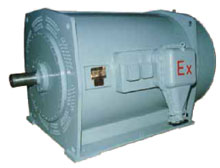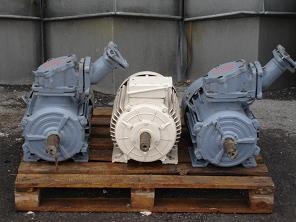Installation of explosion-proof electric motors
Usually, explosion-proof electric motors come from assembled factories. All of them are like this, the electric motor is supplied with a technical sheet and instructions for installation and operation.
Disassembly of the electric motor during installation is carried out only if an open winding is detected or the insulation resistance in Mohm, relative to the housing, measured with a megohmmeter 1000 V -lower R = U / (1000 + 0.001)n, where U — Rated voltage, V; N — electric motor power, kW.
For electric motors with a voltage of 6 aphids of 10 kV, the insulation resistance of the windings is measured with a 2500 V megohmmeter, while the insulation resistance should not be lower than 6 Mohm.
 If the insulation resistance of the explosion-proof motor windings is below normal, then it is necessary to dry the motor windings. For air circulation, you must remove the inlet device, regardless of when an electric motor was sent.
If the insulation resistance of the explosion-proof motor windings is below normal, then it is necessary to dry the motor windings. For air circulation, you must remove the inlet device, regardless of when an electric motor was sent.
After drying the windings of an explosion-proof electric motor, check the tightness of fireproof housings. The difference should not be more than indicated in the instructions. If the electric motor does not meet these requirements, then it cannot be used as explosion-proof.
Explosion-proof electric motors of the VAO series are produced for voltages 380/600 V and power up to 315 kW and have 6 types of input devices that differ in the diameter of the pipe thread for direct entry of armored cables with paper insulation of different sections.

The introduction of wires and cables into an explosion-proof electric motor is carried out according to the instructions. When approaching explosion-proof electric motor cables of brands BVG, ABVG from the main route, they are laid openly on trays or mounting profiles without additional protection against possible mechanical influences and regardless of the laying height.
If the distance from the lower connector of the input device of the electric motor to the point of attachment of the cable is no more than 0.7 m, then additional fasteners for cables are not made, but at large distances they put a tray with a cable laid on it.
Openly laid armored and non-armored cables of other brands (for example, VVBG, VRBG, etc.), when connected to an explosion-proof electric motor is protected from possible mechanical impacts at a height of at least 2 m from the floor or service area. The cable is protected by mounting profiles, steel boxes, water and gas pipes.
When feeding wires or cables laid in pipes and coming out of the floor, the pipes must have a binding that is specified in the project.

After installing an explosion-proof electric motor in place, the pipes are brought to the inlet device and inserted with a short thread into the compression sleeve. Protection of armored cables in the area between the pipes coming out of the floor and the input device, the electric motor can be made with a mounting profile or a steel box.
When measuring the pipe, the compression sleeve is bolted all the way to the cable sleeve or to the body of the input device. Tighten the bolts evenly to avoid warping the sleeve and damaging the bolt threads.
If the diameter of the delivered pipe is smaller than the diameter of the hole in the compression sleeve, then a transition sleeve is screwed into the compression sleeve.
Electric motor circuits that are mounted on foundations subject to vibration are supplied with flexible portable cables with rubber insulation.
